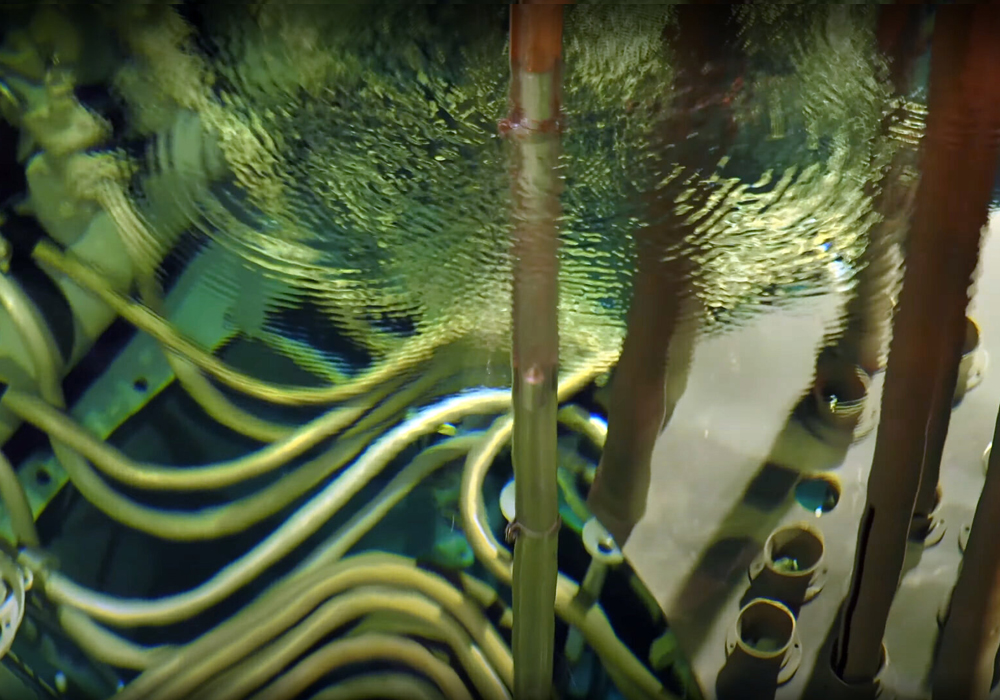
Irradiation container placed in the MARIA reactor core. Credit: National Centre for Nuclear Research
Without accurate diagnostics, it is difficult to talk about effective treatment of patients, especially in the case of cancer. Today, as much as 80% of diagnostic procedures using radiopharmaceuticals require the use of molybdenum-99. In the future, the production efficiency of this valuable radioisotope can be increased using uranium targets prepared by spatial printing.
The European patent for such a solution has just landed in the hands of scientists from the National Centre for Nuclear Research (NCBJ) in Świerk, Poland.
"The global demand for molybdenum-99 is huge. It is a radioisotope that is usually produced in research nuclear reactors, i.e., in devices with limited production capacity. That is why it is so important to constantly improve the methods of its production," says co-inventor of the patent Prof. Paweł Sobkowicz (NCBJ).
Modern techniques of imaging the structure and functions of the human body largely depend on radiopharmaceuticals, which are active substances containing appropriately selected radioactive isotopes. Once the radiopharmaceutical is introduced into the patient's body, its flow rates (or accumulation sites) can be monitored by recording the photons emitted by the nuclei of the decaying radioisotope.
Metastable technetium-99m is one of the most important radioisotopes in medicine. The photons it emits do not cause damage to tissue and are registered by the detectors of diagnostic equipment without much difficulty. In addition, the half-life of this radioisotope is only six hours, which means that it disappears from the patient's body soon after the test.
The short half-life of metastable technetium-99m is an advantage from the point of view of the subject. It is a challenge for diagnosticians because it imposes a radical limitation on the time that may elapse between the production of the radioisotope and the diagnostic procedure. The solution to the problem has been known for years: it is not technetium that ends up in hospitals, but molybdenum-99, which is disintegrating into it.
The half-life of molybdenum-99 is 67 hours. This is the time that ensures the possibility of secure transport of the radioisotope from the place of production to the hospital.
"Molybdenum-99 is most commonly produced by irradiating small targets containing low-enriched uranium-235 with neutrons," says Maciej Lipka, one of the co-authors of the patent.
"Reactor neutrons have a limited ability to penetrate the target material. To ensure that as many uranium-235 nuclei as possible are converted to molybdenum-99, the targets are typically prepared as thin plates from a dispersion of uranium or its oxide or silicide in aluminum. The tile production process does not leave much room for optimization. Therefore, we proposed a different way to prepare uranium targets: spatial printing by laser powder sintering."
Laser sintering of metal powders is a type of 3D printing based on the use of a laser of appropriate power to selectively melt a thin layer of powder, previously evenly distributed inside the container on the working platform. After the first layer is fixed, the platform is lowered slightly, the next layer of powder is applied and the whole cycle can be repeated as many times as required.
"3D printing techniques have been known for a long time, but so far they have not been used to produce uranium targets for neutron irradiation in reactors. However, we believe that this way of producing targets can have a number of advantages," says Prof. Sobkowicz.
In a target exposed to neutrons, nuclear reactions take place, the byproduct of which is heat. The use of 3D printing allows optimization of the shape of the targets so that the heat is more effectively dissipated to the environment. The targets themselves would therefore heat up less, and this would increase the uranium-235 content in them. As a result, more molybdenum-99 could be produced per exposure.
"When firing neutrons in a uranium target, not only molybdenum-99 is formed, but also many other isotopes. After removal from the reactor, each target must therefore be subjected to appropriate chemical treatment, which serves to isolate the molybdenum. Meanwhile, with the help of spatial printing, it is possible to prepare, for example, openwork targets with a very large active surface area, interacting more effectively with chemical solvents," says Lipka.
Possibly the most promising aspect of the patent relates to the potential to increase the processing efficiency of the uranium-235 itself. In each irradiated target, some of the nuclei of this isotope do not undergo nuclear transformations. The shapes of the printed targets can therefore be designed to increase the amount of uranium recovered. Once extracted, it could be used to build more targets.
Currently, more than 10% of the world's demand for molybdenum-99 is covered by the Polish research nuclear reactor Maria, located in Świerk near Warsaw. NCBJ also operates the POLATOM Radioisotope Center, a producer of technetium generators and many radiopharmaceuticals. POLATOM products are exported to over 70 countries.